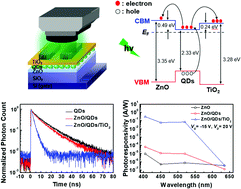Improving the photoresponsivity and reducing the persistent photocurrent effect of visible-light ZnO/quantum-dot phototransistors via a TiO2 layer†
Abstract
Conventional visible-light phototransistors based on the heterostructure of wide band gap zinc oxide (ZnO) and colloidal quantum dots (CdSe/ZnS QDs) have been studied. However, it is found that there are various deteriorated characteristics for their photoelectric behavior. Here, the phototransistors of an additional thin layer of TiO2 deposited onto the ZnO/QDs film using atomic layer deposition are developed for improving the performance of phototransistors. Small band gap QDs can absorb low-energy visible light and generate photoexcited charge carriers, which can be injected into the conduction band of wide band gap ZnO. Subsequently, the photoexcited charge carriers can be injected into the conduction band of TiO2 owing to the low injection barrier. Therefore, the ZnO/QDs phototransistor with the TiO2 layer can generate a larger photocurrent from visible light compared to a device without the TiO2 top layer. Moreover, the inorganic TiO2 layer improved the stability of the device. Under illumination with light at a wavelength of 520 nm, the maximum photosensitivity of the device was 4.2 × 106 and the transition rate was 0.728 ns−1, which is high enough to reduce the persistent photocurrent effect. This work offers a useful method to enhance the performance of visible-light phototransistors based on a heterostructure of oxide semiconductors and QDs.

- This article is part of the themed collection: Journal of Materials Chemistry C HOT Papers


 Please wait while we load your content...
Please wait while we load your content...